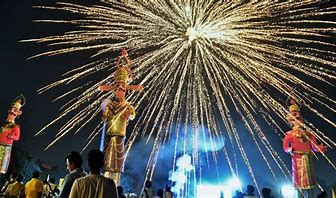Dussehra celebrated with religious farvour all over India
Dussehra in India was celebrated with much religious fervor and gaiety throughout the country, from Kashmir to Kanyakumari.
It culminated following the symbolic killing of Ravana by Lord Ram following the battle.
The occasion was celebrated amid Navratri offerings to goddess Durga, the greatest and the most powerful female deity in Hindu religion and culture.
On one hand, street corners and open fields and parks witnessed an unaccounted number of pandals where Durga idols were colorfully decorated and offerings made, the occasion also marked the staging of Ramlila….the life and times of Lord Ram.
Dussehra, in Hinduism, holiday marking the triumph of Rama, an avatar of Vishnu, over the 10-headed demon king Ravana, who abducted Rama’s wife, Sita. In the epic Ramayana, Rama, with the assistance of the monkey-general Hanuman, attacks Lanka to rescue Sita and slays Ravana. The festival’s name is derived from the Sanskrit words dasha (“ten”) and hara (“defeat”).
The culmination of Navratri and Durga Puja celebrations
Symbolizing the victory of good over evil, Dussehra is celebrated on the 10th day of the month of Ashvina (September–October), the seventh month of the Hindu calendar, with the appearance of the full moon, an event called the “bright fortnight” (shukla paksha). Dussehra coincides with the culmination of the nine-day Navratri festival and with the tenth day of the Durga Puja festival. Both Navratri and Durga Puja involve prayers offered to the goddess Durga, a principal form of the supreme goddess in Hinduism. A collective of nine avatars of the deity, called Navadurga, is worshipped during Navratri. Durga Puja honors the goddess’s demon-slaying form, known as Mahishasuramardini. The coinciding days of Dussehra and Vijaya Dashami mark the victory of Rama over Ravana for some, and of Durga over Mahishasura for others. For many, it marks the beginning of preparation for Diwali, which occurs 20 days after Dussehra.

